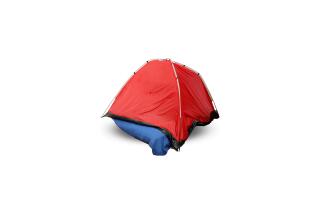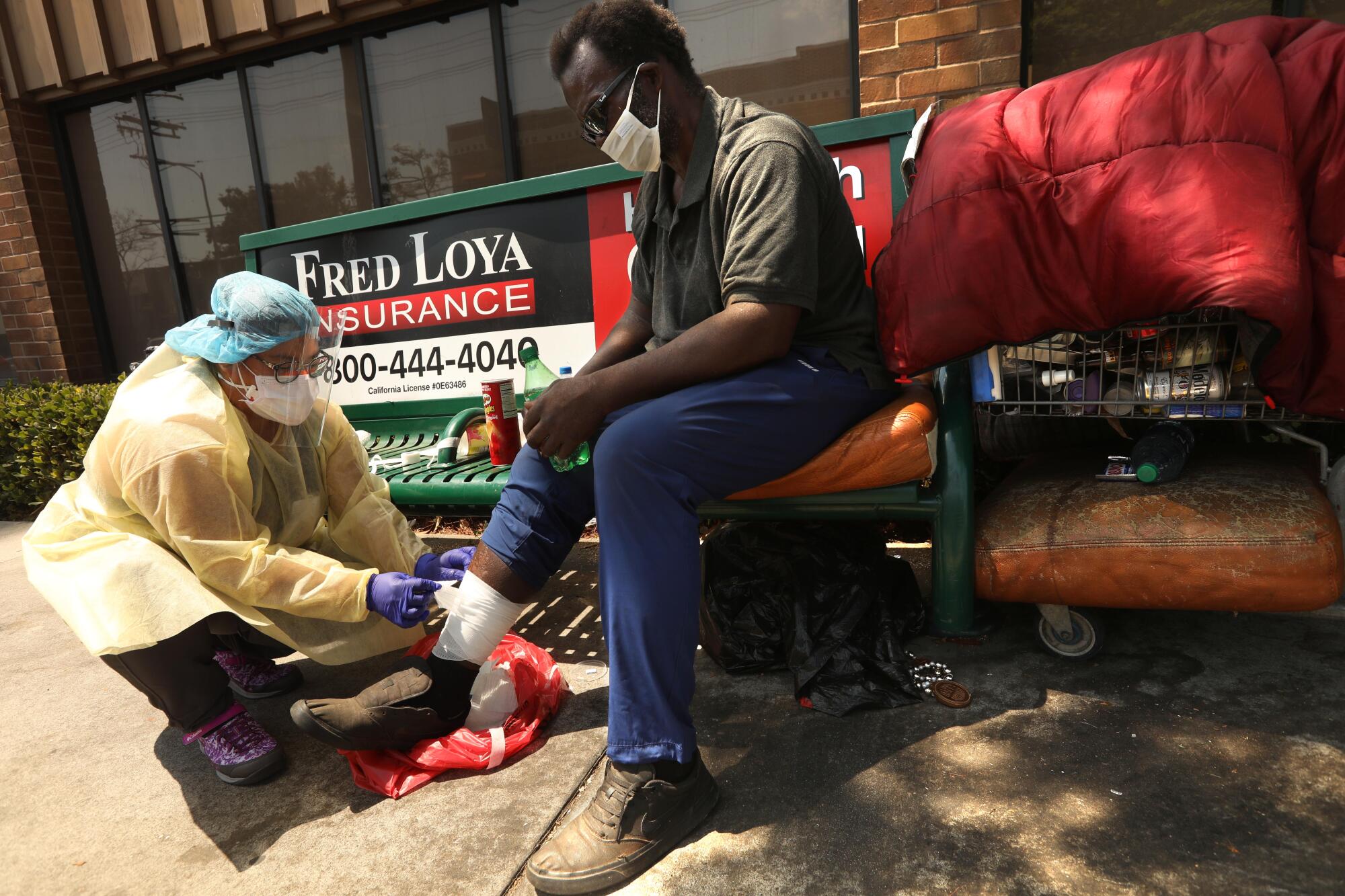
A mid-morning line formed at the entrance to The Center in Hollywood last week, as an employee checked the temperature of homeless people waiting for free care packages of food and water.
On nearby streets, The Center’s outreach workers delivered water and food to increasingly desperate people whose lives have been turned upside down by pandemic shutdowns. They can’t go to a library to take a breather, they can’t go to restaurants to use the restrooms.
A 57-year-old woman with a history of physical and mental illness sat near The Center’s gate and told me she’s been homeless for 25 years and is hoping to get indoors permanently, finally. Nearby, social workers were chatting about how she needed housing with medical care, rather than just a motel room.
Los Angeles had a big enough challenge as it was, trying to address the needs of a growing population of homeless people. It did not need the coronavirus on top of that, nor did it need this wretched, blistering heat wave.
I reached out to Rudy Salinas, whom I’ve known for years, to ask how it was going. Salinas is chief program manager at Blessed Sacrament, and his inexhaustible commitment to the cause has earned him respect from public officials, community leaders and homeless people alike.
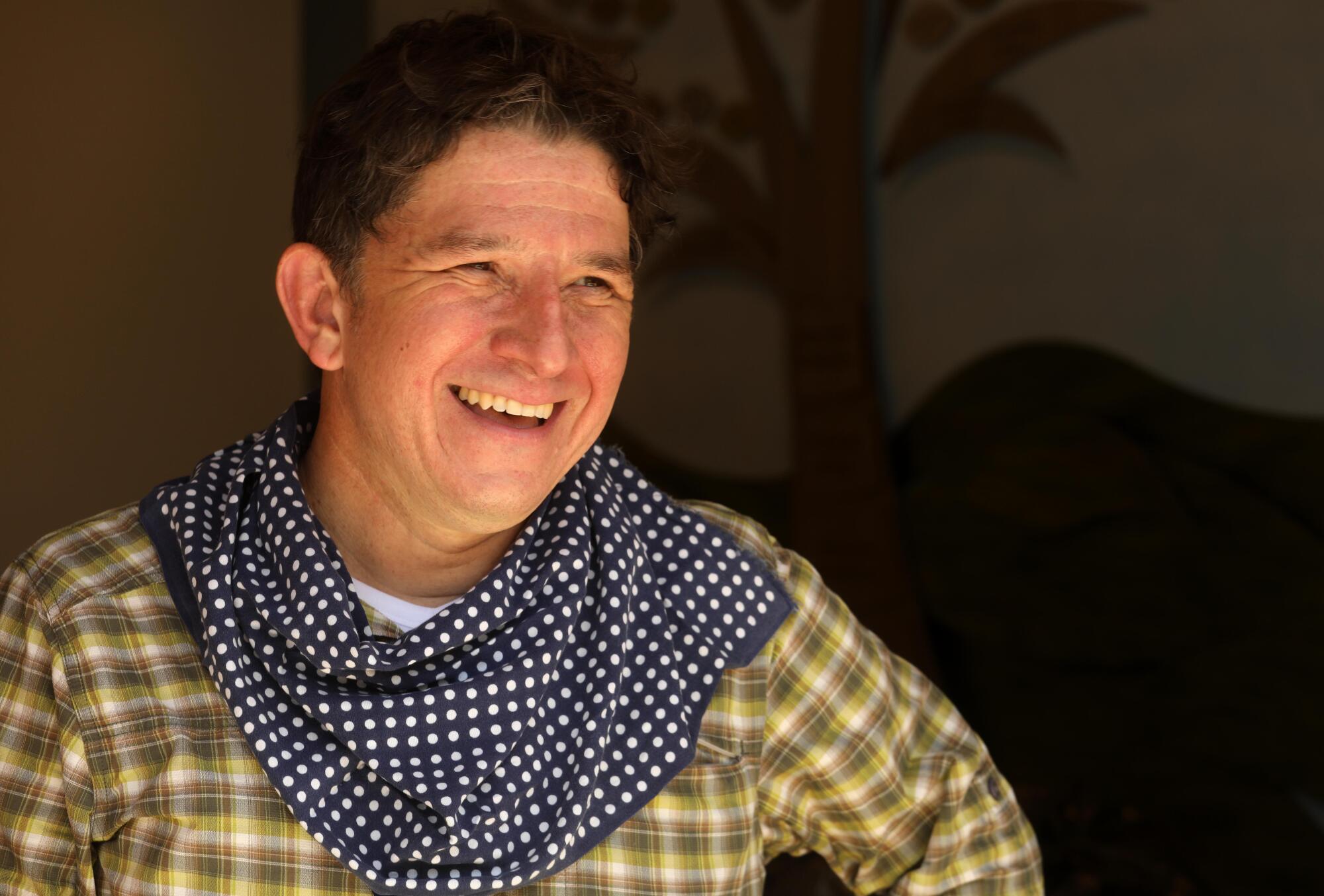
Salinas told me he had never worked longer hours or dealt with more stressful challenges. People are hungry, thirsty, sunburned and desperate, he said, and he’s seeing new faces in the crowds of those seeking help. He was working outside near MacArthur Park with a group of homeless people slated to get into a Project Room Key hotel his agency manages, when strangers approached to ask if they could get in line.
“These were people who were not employed anymore and had been evicted and were sleeping in cars with their families,” said Salinas.
One day, Salinas said, outreach workers helped a woman who had been released from jail, was not taking medication for her mental illness, and was wandering down the middle of a street, puzzled by the absence of the usual frenzy.
“She was trying to get hit by a car, not knowing the pandemic had started and thinking the rapture had happened,” said Salinas.
I thought back to a year ago, when there was reason for faint optimism about the possibility of beginning to turn the tide on L.A.’s growing homeless population, even as encampments expanded throughout the county.
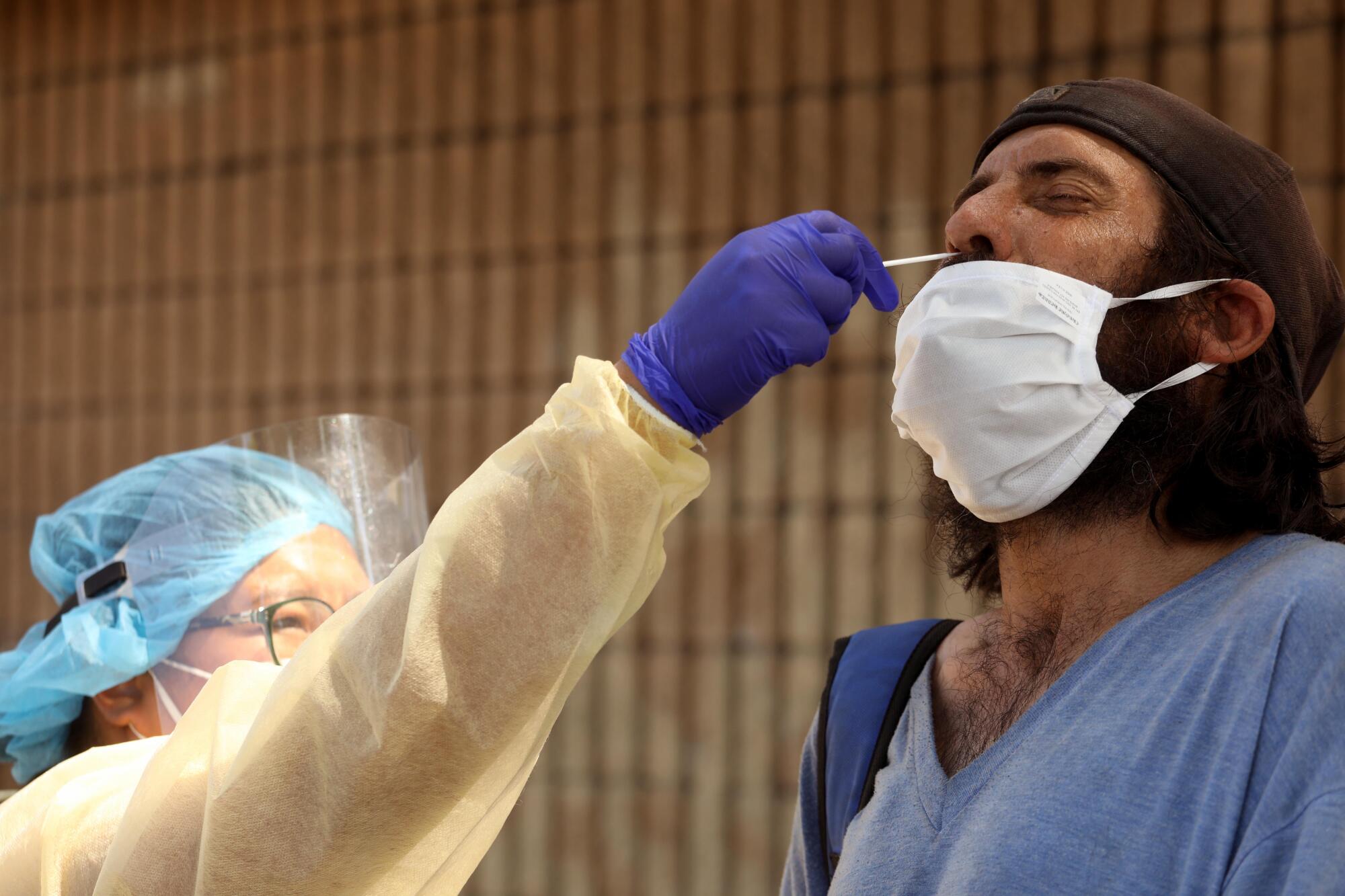
Public officials were admitting, finally, that a strategy shakeup was needed, and that new housing was too costly and taking too long to build. The reorganization of the Los Angeles Homeless Services Authority was proceeding under the leadership of board chair Sarah Dusseault. And I was packing for a trip to Trieste, Italy, with local officials on their way to study a mental health services model they planned to test in Hollywood.
But the virus has stunted progress on many fronts, and the Trieste pilot is on hold indefinitely. The top priority has shifted to rapidly identifying the most elderly and vulnerable homeless people to get them indoors and keep them safe and virus-free.
“The focus shifted to saving lives,” said Dusseault, who suspects the total number of homeless people has decreased somewhat, but there’s no solid data on that and the ruptured economy could swamp any gains. “I do think that Project Room Key showed what we could do, moving 5,000 people indoors — and it’s more if you count the rec centers and other settings — since mid-March.”
That number fell short of goals, and it remains to be seen if another goal can be met — eventually moving those people, and thousands more, into permanent housing.
At the The Center, Executive Director Nathan Sheets said the virus led to a pivot for his team, from a focus on building relationships and providing service to people in line for housing, to a focus on immediate aid, including food and water delivery and testing stations for COVID-19.
“I’m seeing a lot of people who have been left out of Project Room Key in Hollywood, and I feel like I’ve never seen so many people wandering down the street not wearing shoes and looking just completely sick.”
— Douglas Walker, outreach coordinator at The Center at Blessed Sacrament

“We’re going to the hot spots and … identifying people who are extremely vulnerable, with underlying medical conditions, and whisking them away to quarantine or Project Room Key,” said Sheets.
Some can’t be coaxed indoors — due to mental illness, addiction, a distrust of authority, fear of shelters, a lack of indoor space or all of the above. Sheets and Salinas said authorities provided tents early on to shelter and isolate such stragglers, and in some cases tents were built around those who refused to give up their small patch of real estate.
Still, some of the neediest remain out of reach.
“I’m seeing a lot of people who have been left out of Project Room Key in Hollywood, and I feel like I’ve never seen so many people wandering down the street not wearing shoes and looking just completely sick,” said Douglas Walker, outreach coordinator at The Center.
Walker said there hasn’t been “adequate coordination” in determining who among the homeless is most vulnerable. And he thinks there’s a focus on encampments, because they’re flashpoints for complaints, sometimes to the exclusion of severely ill people who isolate along freeway offramps and disappear into the weeds.
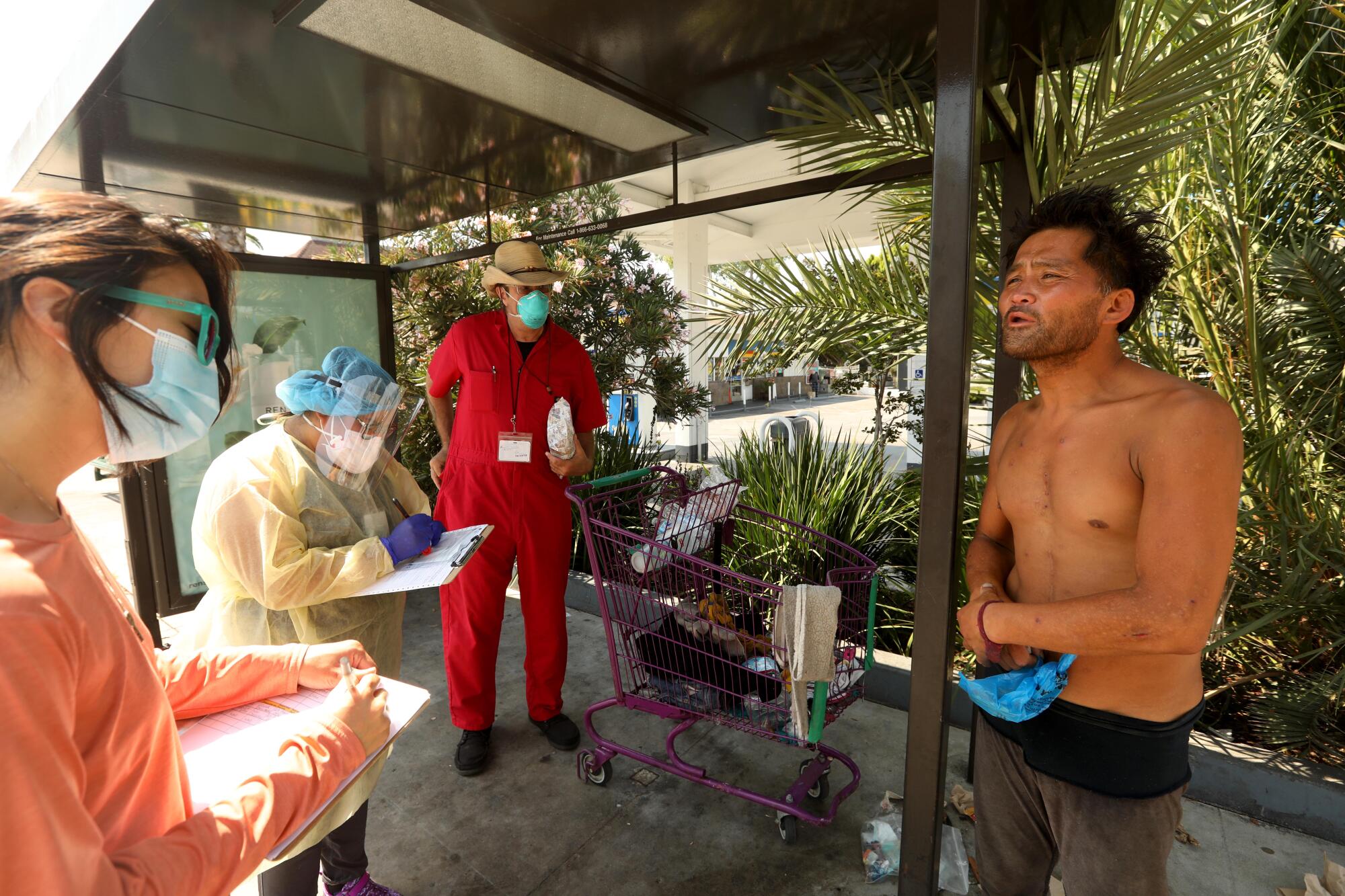
Kerry Morrison, who alerted local officials to the more holistic Trieste model and led the local delegation there, lamented the delay in making Hollywood a testing ground for its community-based mental health approach. Such a switch would have complemented the movement to defund police.
“Part of the vision was a whole crisis response protocol that would not involve law enforcement and paramedics, but 24-hour teams roving neighborhoods, with a psychiatric urgent care center to take people to rather than a hospital that kicks them back onto the street,” said Morrison.
When the pandemic hit, Morrison was impressed by the way in which city and county officials treated homelessness like the emergency it had been for years, bulldozing bureaucracies that might have held up Project Room Key or moving people into rec centers. But now the progress has stalled a bit, she said, to the point where it’s not always clear what the role of rec centers will be or who will decide.
Just as the city and county stepped up in March, so did dozens of residents, faith groups, public officials, healthcare providers, law enforcement officials, nonprofit reps and merchants who strategize in weekly virtual meetings of the community coalition that calls itself Hollywood 4WRD. Members share notes, organize food and water delivery, problem-solve the lack of public toilets and showers and lately have lobbied to reopen the Cole Rec Center as a temporary shelter.
For all those successes, Morrison said, some Hollywood 4WRD participants have recently observed an increased level of deterioration in people still on the street, and she fears there’s a creeping weariness among those working hardest to make a difference.
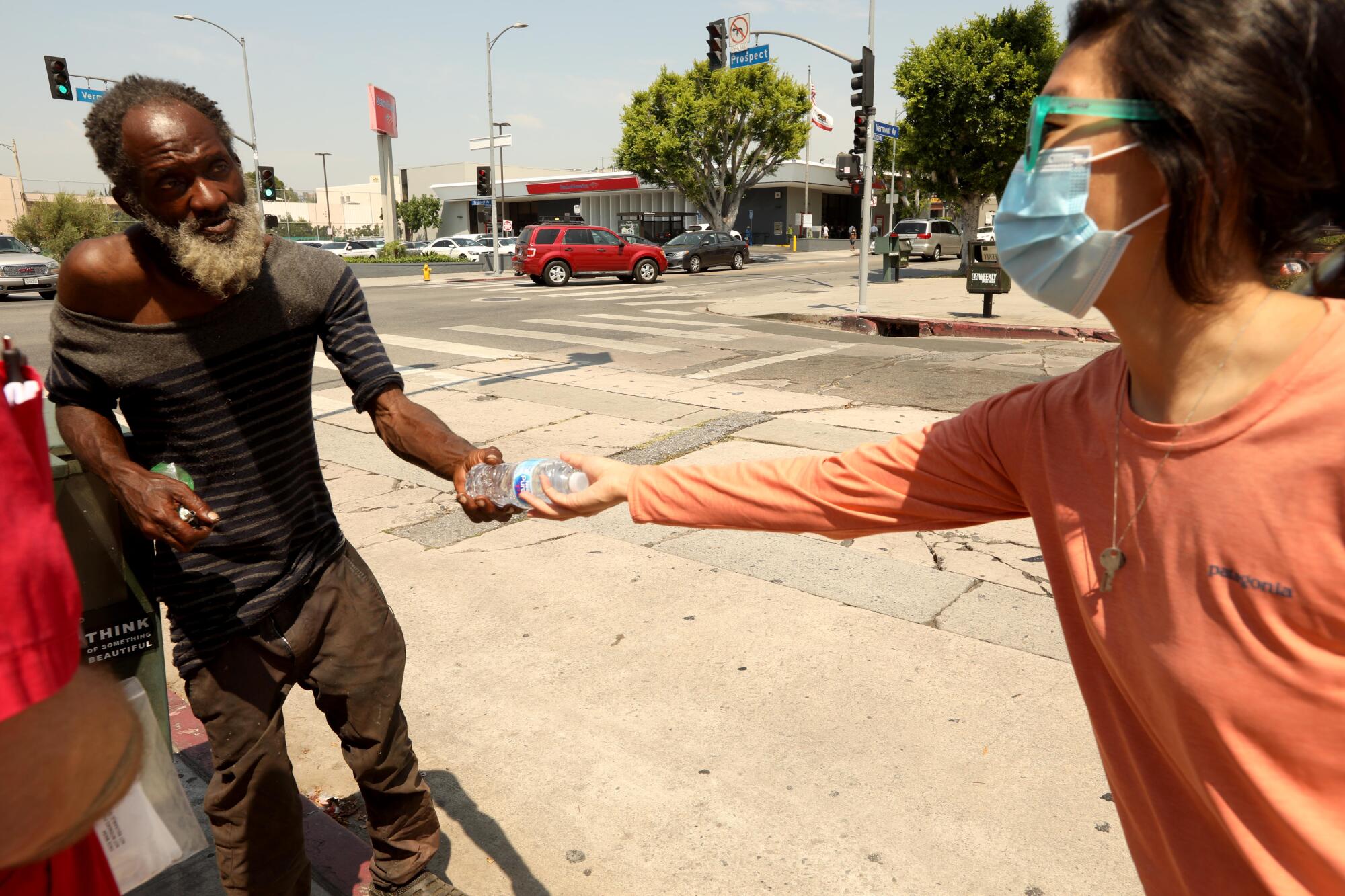
It’s not likely to happen to Rudy Salinas. He texted me last week, saying to meet him at Cherokee and Sunset, where an outreach team that included a nurse had set up a medical station on the sidewalk to perform coronavirus tests.
When I got there, I couldn’t find him at first. Then I noticed Salinas hustling across Cherokee with a giant thermos of coffee, juggling cups. With a mask for protection, he knelt before two homeless men, asking if they wanted coffee, how many creams and sugars, how you doing guys, so on and so forth, looking into their eyes, making a connection.
It’s hard work that takes heart, and patience, and sometimes it makes all the difference.
More to Read
Sign up for Essential California
The most important California stories and recommendations in your inbox every morning.
You may occasionally receive promotional content from the Los Angeles Times.


